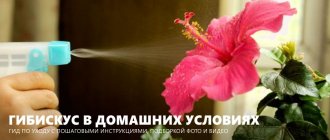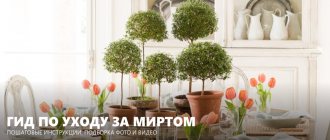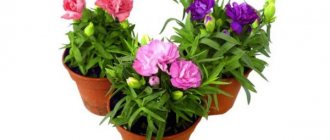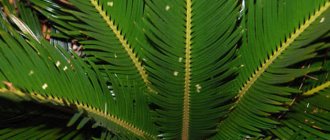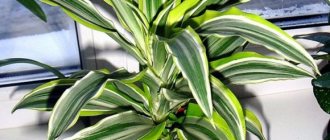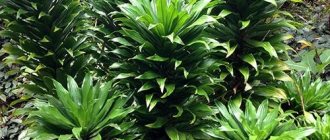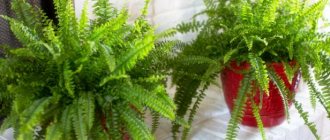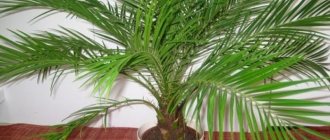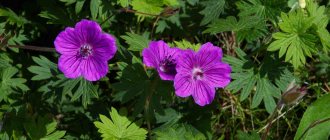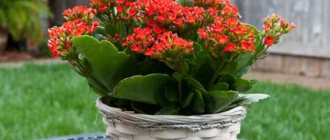Photo gallery
The plant is often mistaken for arrowroot, stromanta and calathea; it can be distinguished by its longer petioles and oval-elongated leaves.
Important! The plant is poisonous and poses a danger to children and pets.
Flowering and fruiting
The leaves are large, oval or oval-elongated, tapering towards the base, and arranged asymmetrically. Due to the short internodes, they seem to be collected in bunches.
In the evening the leaves close, rising up, and in the morning they fall. Thanks to the long petioles and large leaves, this process is accompanied by a characteristic rustling sound.
The main background of the leaves is bright or light green, with a clearly visible pattern of light green, yellow, gray or white stripes.
Small flowers of white-green, light pink, yellow or purple are collected in spikelet inflorescences pressed to the petioles.
At home it blooms extremely rarely.
Botanical description of the plant
Ctenanta is a very popular indoor plant, valued primarily for the unusual colors of its leaves; it is not without reason that it is often called the comb flower or crocodile leaf. This unusual evergreen perennial, belonging to the Marantaceae family, is native to the hot tropics of sunny Brazil, but the plant is also found in some regions of Central America, in particular in Mexico and Costa Rica.
Did you know? Brazil is rightfully considered one of the richest countries in terms of flora and fauna. Its flora and fauna are represented by approximately 4 million species, some of which are not found anywhere else.
The botanical characteristics of ctenanta are given in the table:
| Maximum dimensions | Up to 2 m |
| Root system | Tough, highly branched, fibrous |
| Stem | Herbaceous type, thin |
| Leaf Shape | Asymmetrical, not carved, in the form of an elongated oval with an expanded lower part, collected in dense tiers, very close to each other so that they look like bunches |
| Leaf size | 20–40 cm |
| Leaf color | Green of different shades with decorative stripes, veins or inclusions directed from the center to the edges |
| Leaf structure | Soft |
| Inflorescence | Ear |
| Flowers | Bisexual, small, devoid of decorativeness, covered with dense bracts |
| Fruit type | Box |
| Taste of fruits | The fruits are not edible |
Signs and superstitions
Ktenanta is the protector of the family hearth. Being in the spouses' bedroom helps strengthen family ties; in the children's room it helps a restless child calm down and find inner balance.
Helps get rid of fatigue and stress, create a calm atmosphere, find peace and understanding in the family.
According to Feng Shui, this is a plant with masculine Yin energy. It is recommended to place it in the work area, a teenager’s room, or a place where cheerful and noisy groups gather.
Helps avoid conflict situations, protects household members from illness, and eliminates negative energy.
Ktenanta Oppenheim: history
Oppenheim's ctenanta was discovered in the jungles of South America by Spanish missionaries in the late 18th century. The first description of the plant was made by the German botanist E. Morren, who gave it the name “Oppenheim’s calathea.” However, after a more detailed study of this perennial, the scientist changed its name and “Oppenheim’s calathea” became “Oppenheim’s arrowroot.” Confusion with names continued for several decades, until in 1895 the German botanist Karl Moritz Schumann isolated this exotic into a separate genus, Ktenantha, where it remains to this day.
Home care
Temperature and humidity
For normal growth and development of the ctenant, the air temperature in spring and summer should be +22-25 °C, in winter – +16-20 °C.
Due to hypothermia of the roots, the plant may die, so it is important to monitor the soil temperature, the optimal value is +20-22 °C.
Throughout the year, the humidity level should not fall below 70-80%; for this it is necessary to spray the plant and the air around it several times a day, use a humidifier, pour wet expanded clay into a tray, and cover the color with a plastic bag at night.
Lighting and comfortable place
Variegated varieties of ctenantha need diffused light; species with monochromatic leaves feel comfortable in partial shade.
Important! With an excess of bright light and under the influence of sunlight, the leaves of the plant fade.
Daylight should last at least 12-14 hours, and in winter additional artificial lighting will be required.
It is best to place the plant on the windowsill of a western or eastern window.
Shade tolerance
Shade tolerance depends on the leaves: the darker they are, the less light required. However, with a prolonged lack of light, the foliage will lose its brightness and the plant will stop growing.
Trimming
With uncontrolled growth, the ctenant loses its decorative effect: new shoots are too weak, due to lack of space, the leaves become small and turn yellow.
It is necessary to promptly and regularly remove long shoots and trim off limp and dried leaves, the place of which will be taken by new ones.
Care during the rest period
For growth and development, the ctenant does not need a pronounced period of rest. In order for her to rest enough in winter, lower the air temperature, reduce watering and fertilizing. Lighting requirements remain the same.
Difficulties in caring for a ctenanta and overcoming them
| Appearance | Problem | Solutions |
| Slow growth, drooping stems. | Increased air temperature. | Place the flower away from the radiator and ventilate the room regularly. |
| Falling of healthy leaves. | Draft or low humidity. | Set the humidifier to at least 80%. Remove the pot from the window. |
| Faded leaves, spots and stripes disappear. | Abundance of ultraviolet light. | Shade or move the pot from the south window to any other. |
| Blackening of stems. | Rotting associated with coolness and high humidity. | Replant in new soil, increase air temperature. |
| Twisting sheet plates. | Lack of water. | Spray and water more often. |
| Yellow-brown foliage color. | Lack of minerals in the soil. | Use fertilizer. |
What kind of pot do you need?
The pot needs to be wide and not very high; during replanting, the new container should be 3-4 cm larger than the previous one. In a pot that is too spacious, water will accumulate, which will lead to the development of root rot.
The most suitable material is ceramics, due to the porosity of which it is easier to avoid waterlogging.
The flowerpot must have drainage holes. Walnut or eggshells, small pebbles, crushed stone, expanded clay, and tree bark are suitable for drainage.
Where can I buy it? Price range
Ktenanta is sold in online and offline flower shops, the cost depends on the size of the flowerpot, height and type of plant and averages 500 rubles. — 10 thousand rubles.
What to do after purchase?
A newly purchased plant should be given about 10-15 days to acclimatize. Replanting is required only in the case of a very overgrown root system.
Spraying
The plant should be sprayed daily, or at least every other day, in the morning or evening. If the humidity level is insufficient, the leaves begin to curl.
For spraying, soft, settled water at room temperature is used.
An important condition: a very fine-grained spray bottle is necessary, since large drops of water leave spots on the leaves, which reduces the decorative appearance of the plant. Sometimes you can give the client a warm shower
However, after the procedure, you must wipe the leaves with a soft cloth so that no drops remain on them.
Sometimes the client can be given a warm shower. However, after the procedure, you must wipe the leaves with a soft cloth so that no drops remain on them.
What kind of soil is needed?
The soil must be nutritious, loose, moisture- and breathable, and have low acidity (pH up to 6.0).
You can use ready-made store-bought soil intended for arrowroot or azaleas, having previously enriched it with charcoal, or prepare it yourself by mixing:
- 1 part sand;
- 1 part peat;
- 2 parts leaf soil.
It is important to ensure that the substrate does not contain lime and spill it with a solution of manganese or treat it thermally to get rid of pests.
Expert opinion
Mokhov Andrey Petrovich
Graduated from KubSAU, specialty: agronomy
Before planting the ctenant, the soil must be checked: if, after squeezing in a fist, it remains free-flowing, you can begin replanting.
Reproduction
Ctenanta is propagated by cuttings, dividing the bush and seeds.
For reproduction you will need:
- soil mixture;
- water;
- flowerpot;
- growth stimulants – “Zircon”, “Epin”, “Kornevin”;
- knife;
- charcoal or cinnamon;
- polyethylene.
By cuttings
For cuttings you need:
- cut branches 8-10 cm long, each cutting should have 1-2 internodes and 2-3 leaves;
- treat the sections with crushed or activated carbon and dip in a solution of “Epin”, “Zircon” or “Kornevin”;
- place the cuttings in a container with water;
- when the roots grow to 0.5-1 cm, transplant into soil, spray and cover with polyethylene to create a greenhouse effect;
- place the greenhouse in a room with bright, diffused lighting and a temperature of +22-25 °C;
- regularly ventilate the greenhouse and water the seedlings;
- After the leaves appear, remove the greenhouse and care for the seedlings as if they were an adult plant.
Reference! Cuttings should be harvested in late spring or early summer.
Dividing the bush
During transplantation, it is necessary to cut the roots into several parts with a sharp sterile knife so that each has several leaves and a developed section of root.
Sprinkle the sections with crushed charcoal or cinnamon powder and dry for several hours.
Place the cuttings in separate containers, spray and cover with polyethylene. As the soil dries, water with a weak solution of a growth stimulator - “Epin” or “Kornevin”.
To speed up the rooting process, it is necessary to provide bright lighting, a temperature of +25-27 °C and use bottom heating. In this way, only large and completely healthy plants over 5 years old can be propagated.
Seeds
Ctenanta is extremely rarely grown from seeds due to the difficulty of obtaining them at home.
To germinate seeds, it is necessary to keep them in greenhouse conditions in constant humidity, in bright light and at a temperature of at least +20 °C, using bottom heating.
Entrances appear after a month, after another 30-40 days they can be planted in separate containers.
Fertilizers
During the growing season, the plant requires regular feeding with fertilizers for leaf crops. They should be added at this time once every 2 weeks. During the dormant period, fertilization should occur no more than once every 1.5 months.
Watering
In spring and summer, the plant needs to be watered approximately every 2 days, in winter - no more than 2 times a week. The regularity of watering depends on the drying speed of the top layer of soil - it should dry 1.5-2 cm deep.
Watering is carried out under the leaves; due to water getting on the leaves, they may change color.
The water should be soft - rain, melt, settled or filtered, slightly above room temperature.
If you are going on vacation
To maintain moisture during a long absence, you need to place the flowerpot on wet pebbles or expanded clay, cover the soil with damp sphagnum moss and cover the plant with a plastic bag.
Feeding rules
Ktenanta does not like excess fertilizer; this must be taken into account and one must restrain one’s desire to frequently water it with nutritional compounds. Her well-being is adversely affected by increased levels of calcium and nitrogen in the soil. In the cold season, it will be enough to feed your pet once a month. In spring and summer, this procedure should be performed more often - once every two weeks.
What fertilizer should I choose for this? It is best to take complex formulations for indoor decorative foliage plants. Fertilizer in liquid form is considered the most convenient. And one moment. The instructions always indicate a high dosage. It is recommended to use it at half dose.
But there is another option. If you have prepared high-quality soil, the plant will not lack nutrients. An annual repotting serves the same purpose. If you adhere to the principles of regularly updating the soil in pots, then you don’t have to think about fertilizing. They will simply be superfluous.
Diseases. Table
| Disease | Signs | Treatment |
| Root rot | The leaves dry and wither, the roots darken and rot. | A replantation is required with a complete replacement of the soil and removal of damaged roots, treatment with fungicides - “Alirin” or “Fitosporin” |
| Powdery mildew | Leaves seem to be dusted with flour | Spray the plant with a solution based on benomyl, theophanate-methyl |
| Sooty fungus | Ktenanta looks like it's covered in soot | Treat affected areas with soap |
Types of ctenanta with photos and names
Ctenanta refers to plants, different species of which differ greatly in appearance from each other.
Oppenheimiana (Ctenanthe oppenheimiana)
One of the most popular types. We love flower growers for their original, catchy appearance and relative unpretentiousness to care and maintenance conditions.
The leaves are oblong, narrow at the base, up to 40 cm in length, dark green in color with striking stripes of different colors, from light green to light silver. The inner side of the leaf is purple. The bush can grow up to 1 meter in height. A remarkable feature is the mobility of the leaves, which curl up with the onset of darkness. At the same time, a slight rustling sound is produced, which can be heard in complete silence, especially if the bush is large. Looks great in the interior of any room.
Ctenanthe lubbersiana
The bush is compact, no more than 75 cm high. It differs from others in the juicy, bright green color of the foliage and original stripes, similar to the feathers of light yellow birds. Another peculiarity is that the foliage retains its color in shading and even in the complete absence of sunlight, under artificial lighting.
Common varieties
Clusia flower - home care
Breeders have developed many interesting and diverse species of ctenanta. Each has characteristic differences:
- Ctenanthe Oppenheimiana. An excellent and unpretentious variety, perfect for beginners. At home, it can grow up to 1.2 m. The leaves of Oppenheim's ctenantha are lancet-shaped and distinguished by alternating gray and gray-green stripes;
- Ctenathe Lubbersiana is another fairly easy-to-care flower. The maximum height of the plant is 1 m. It is distinguished by the presence of oblong dark green leaves in the upper part. The leaves below are pale green with variegated veins;
- pubescent ctenantha (Ctenanthe Setosa). This plant among all species is considered the most capricious. It requires certain indicators of humidity and temperature, and drafts have a very negative effect on it. The leaves of the ctenanthus Setosa flower are ovoid in shape, the dark green shade is diluted with light green stripes. The maximum flower height is 80 cm;
Ktenanta Oppenheim
- Ctenanthe Amagris is a fairly well-known variety. The leaves are oval, they can reach up to 20 cm in length. The color is silver-green with dark veins. In the lower part, the leaves are burgundy in color, which makes the plant especially decorative;
- Ctenanthe Compressa. An interesting type of crop up to 0.9 m in size. The leaves are oval and up to 30 cm long. They have a rich green tint and a glossy surface;
- Ctenanthe Burle-Marxii. This flower is the lowest, up to 20 cm. The small leaf blades look quite original - thick and rectangular-like. Wide dark stripes are noticeable on the upper part, and a dark red surface below.
Note! Many people often confuse the types of Calathea ctenanthus, but the main difference between the plants is the shape of the inflorescence. In the first it is very similar to a scallop, in the second it is like a basket.
